Indeterministic Data Collection in UAV-Assisted Wide and Sparse Wireless Sensor Network
Abstract
:1. Introduction
1.1. Background and Motivation
1.2. Contribution
- We model a UAV-assisted wide and sparse wireless sensor network and formulate a novel indeterministic data collection problem. By our consideration, only a part of ground SNs obtain effective sensing data that contain target information. Under the wide and sparse wireless sensor network assumption, UAVs are not able to fly over and serve all of the SNs ergodically due to limited onboard energy. Accordingly, we formulate an effective data block sum maximization problem that aims to maximize the number of effective data blocks within a limited flying period.
- We propose a joint UAV trajectories design, SN serve scheduling and UAV-SN association algorithm. In particular, to deal with the indeterministic effectiveness indicator, we reformulate the problem by introducing an effective probability prediction model based on Deep Neural Network (DNN). Furthermore, to tackle the difficulty of varying constraints brought by partial data collection, a modified knapsack algorithm is improved.
- We provide numerical results to verify the performance of the proposed algorithm. We show that, compared to the non-effective prediction (NEP) scheme, the proposed scheme with effective probability prediction (EP) consumes much less time for collecting the same percent of effective data blocks. Besides, the proposed algorithm adopting EP based on DNN shows performance gain against the baseline algorithm adopting EP based on Random Forests (RF).
2. System Model
2.1. UAV-Assisted Wide and Sparse WSN
2.2. Indeterministic Data Collection
2.3. Average Data Collection Rate
3. Effective Data Block Sum Maximization
4. Effective Probability Prediction and Problem Reformulation
4.1. Data Effective Probability Prediction
4.2. Problem Reformulation
5. Modified Knapsack Algorithm
5.1. The Feasibility Problem of
5.2. Algorithm Design
| Algorithm 1 Hybrid greedy algorithm for |
|
6. Numerical Results
6.1. DNN-Based Effective Probability Prediction
6.2. Illustrations of Optimized UAV Trajectories and SN Serve Scheduling
6.3. Collected Data Block Ratios
7. Conclusions
Author Contributions
Funding
Institutional Review Board Statement
Informed Consent Statement
Data Availability Statement
Conflicts of Interest
References
- Shahid, M.; Tariq, M.; Iqbal, Z.; Albarakati, H.M.; Fatima, N.; Khan, M.A.; Shabaz, M. Link-quality based energy-efficient routing protocol for WSN in IoT. IEEE Trans. Consum. Electron. 2024, 70, 4645–4653. [Google Scholar] [CrossRef]
- Shen, X.; Yi, B.; Liu, H.; Zhang, W.; Zhang, Z.; Liu, S.; Xiong, N. Deep variational matrix factorization with knowledge embedding for recommendation system. IEEE Trans. Knowl. Data Eng. 2019, 33, 1906–1918. [Google Scholar] [CrossRef]
- Lin, C.; Xiong, N.; Park, J.H.; Kim, T.H. Dynamic power management in new architecture of wireless sensor networks. Int. J. Commun. Syst. 2009, 22, 671–693. [Google Scholar] [CrossRef]
- Lin, C.; He, Y.X.; Xiong, N. An energy-efficient dynamic power management in wireless sensor networks. In Proceedings of the 2006 Fifth International Symposium on Parallel and distributed computing, Timisoara, Romania, 6–9 July 2006; pp. 148–154. [Google Scholar]
- Guo, W.; Xiong, N.; Vasilakos, A.V.; Chen, G.; Yu, C. Distributed k–connected fault–tolerant topology control algorithms with PSO in future autonomic sensor systems. Int. J. Sens. Netw. 2012, 12, 53–62. [Google Scholar] [CrossRef]
- Shu, L.; Zhang, Y.; Yu, Z.; Yang, L.T.; Hauswirth, M.; Xiong, N. Context-aware cross-layer optimized video streaming in wireless multimedia sensor networks. J. Supercomput. 2010, 54, 94–121. [Google Scholar] [CrossRef]
- Yang, Y.; Xiong, N.; Chong, N.Y.; Defago, X. A Decentralized and Adaptive Flocking Algorithm for Autonomous Mobile Robots. In Proceedings of the 2008 The 3rd International Conference on Grid and Pervasive Computing-Workshops, Kunming, China, 25–28 May 2008; pp. 262–268. [Google Scholar]
- Zhang, W.; Zhu, S.; Tang, J.; Xiong, N. A novel trust management scheme based on Dempster–Shafer evidence theory for malicious nodes detection in wireless sensor networks. J. Supercomput. 2018, 74, 1779–1801. [Google Scholar] [CrossRef]
- Sang, Y.; Shen, H.; Tan, Y.; Xiong, N. Efficient protocols for privacy preserving matching against distributed datasets. In Proceedings of the Information and Communications Security: 8th International Conference, Raleigh, NC, USA, 4–7 December 2006; pp. 210–227. [Google Scholar]
- Xu, W.; Fang, W.; Ding, Y.; Zou, M.; Xiong, N. Accelerating federated learning for iot in big data analytics with pruning, quantization and selective updating. IEEE Access 2021, 9, 38457–38466. [Google Scholar] [CrossRef]
- Shen, Y.; Fang, Z.; Gao, Y.; Xiong, N.; Zhong, C.; Tang, X. Coronary arteries segmentation based on 3D FCN with attention gate and level set function. IEEE Access 2021, 7, 42826–42835. [Google Scholar] [CrossRef]
- Wei, Z.; Zhu, M.; Zhang, N.; Wang, L.; Zou, Y.; Meng, Z.; Feng, Z. UAV-assisted data collection for Internet of Things: A survey. IEEE Internet Things J. 2022, 9, 15460–15483. [Google Scholar] [CrossRef]
- Zhang, L. Joint Energy Replenishment and Data Collection Based on Deep Reinforcement Learning for Wireless Rechargeable Sensor Networks. IEEE Trans. Consum. Electron. 2023, 70, 1052–1062. [Google Scholar] [CrossRef]
- Liu, X.; Song, H.; Liu, A. Intelligent UAVs trajectory optimization from space-time for data collection in social networks. IEEE Trans. Netw. Sci. Eng. 2020, 8, 853–864. [Google Scholar] [CrossRef]
- Li, P.; Xu, J. Fundamental rate limits of UAV-enabled multiple access channel with trajectory optimization. IEEE Trans. Wirel. Commun. 2020, 19, 458–474. [Google Scholar] [CrossRef]
- Wu, Q.; Zhang, R. Common throughput maximization in UAV-enabled OFDMA systems with delay consideration. IEEE Trans. Commun. 2018, 66, 6614–6627. [Google Scholar] [CrossRef]
- Chen, W.; Zhao, S.; Zhang, R.; Chen, Y.; Yang, L. UAV-assisted data collection with nonorthogonal multiple access. IEEE Internet Things J. 2021, 8, 501–511. [Google Scholar] [CrossRef]
- Gu, J.; Wang, H.; Ding, G.; Xu, Y.; Xue, Z.; Zhou, H. Energy-constrained completion time minimization in UAV-enabled Internet of Things. IEEE Internet Things J. 2020, 7, 5491–5503. [Google Scholar] [CrossRef]
- Wang, W.; Zhao, N.; Chen, L.; Liu, X.; Chen, Y.; Niyato, D. UAV-assisted time-efficient data collection via uplink NOMA. IEEE Trans. Commun. 2021, 69, 7851–7863. [Google Scholar] [CrossRef]
- Yuan, X.; Hu, Y.; Zhang, J.; Schmeink, A. Joint user scheduling and UAV trajectory design on completion time minimization for UAV-aided data collection. IEEE Trans. Wirel. Commun. 2023, 22, 3884–3898. [Google Scholar] [CrossRef]
- Li, M.; Liu, X.; Wang, H. Completion time minimization considering GNs’ energy for UAV-assisted data collection. IEEE Wirel. Commun. Lett. 2023, 12, 2128–2132. [Google Scholar] [CrossRef]
- Sun, C.; Xiong, X.; Ni, W.; Wang, X. Three-Dimensional Trajectory Design for Energy-Efficient UAV-Assisted Data Collection. In Proceedings of the 2022 IEEE International Conference on Communications, Seoul, Republic of Korea, 16–20 May 2022; pp. 3580–3585. [Google Scholar]
- Li, P.; Chai, R.; Tang, R.; Pu, R. Long Term Energy Consumption Minimization-based Data Collection for UAV-Assisted WSNs. In Proceedings of the 2023 IEEE 98th Vehicular Technology Conference, Hong Kong, China, 10–13 October 2023; pp. 1–5. [Google Scholar]
- Chen, J.; Yan, F.; Mao, S.; Shen, F.; Xia, W.; Wu, Y.; Shen, L. Efficient Data Collection in Large-Scale UAV-aided Wireless Sensor Networks. In Proceedings of the 2019 11th International Conference on Wireless Communications and Signal Processing, Xi’an, China, 23–25 October 2019; pp. 1–5. [Google Scholar]
- Chai, R.; Gao, Y.; Sun, R.; Zhao, L.; Chen, Q. Time-Oriented Joint Clustering and UAV Trajectory Planning in UAV-Assisted WSNs: Leveraging Parallel Transmission and Variable Velocity Scheme. IEEE Trans. Intell. Transp. Syst. 2023, 24, 12092–12106. [Google Scholar] [CrossRef]
- Li, D.; Xu, S.; Zhao, C.; Wang, Y.; Xu, R.; Ai, B. Data Collection In Laser-Powered UAV-Assisted IoT Networks: Phased Scheme Design Based on Improved Clustering Algorithm. IEEE Trans. Green Commun. Netw. 2024, 8, 482–497. [Google Scholar] [CrossRef]
- Liu, X.; Liu, H.; Zheng, K.; Liu, J.; Taleb, T.; Shiratori, N. AoI-minimal Clustering, Transmission and Trajectory Co-design for UAV-assisted WPCNs. IEEE Trans. Veh. Technol. 2024. [Google Scholar] [CrossRef]
- Zhu, B.; Bedeer, E.; Nguyen, H.H.; Barton, R.; Gao, Z. UAV Trajectory Planning for AoI-Minimal Data Collection in UAV-Aided IoT Networks by Transformer. IEEE Trans. Wirel. Commun. 2023, 22, 1343–1358. [Google Scholar] [CrossRef]
- Zeng, Y.; Zhang, R. Energy-efficient UAV communication with trajectory optimization. IEEE Trans. Wirel. Commun. 2017, 16, 3747–3760. [Google Scholar] [CrossRef]
- Moraru, A.; Pesko, M.; Porcius, M. Using machine learning on sensor data. J. Comput. Inf. Technol. 2010, 18, 341–347. [Google Scholar] [CrossRef]
- Soleymani, S.A.; Goudarzi, S.; Kama, N. A hybrid prediction model for energy-efficient data collection in wireless sensor networks. Symmetry 2024, 12, 2024. [Google Scholar] [CrossRef]
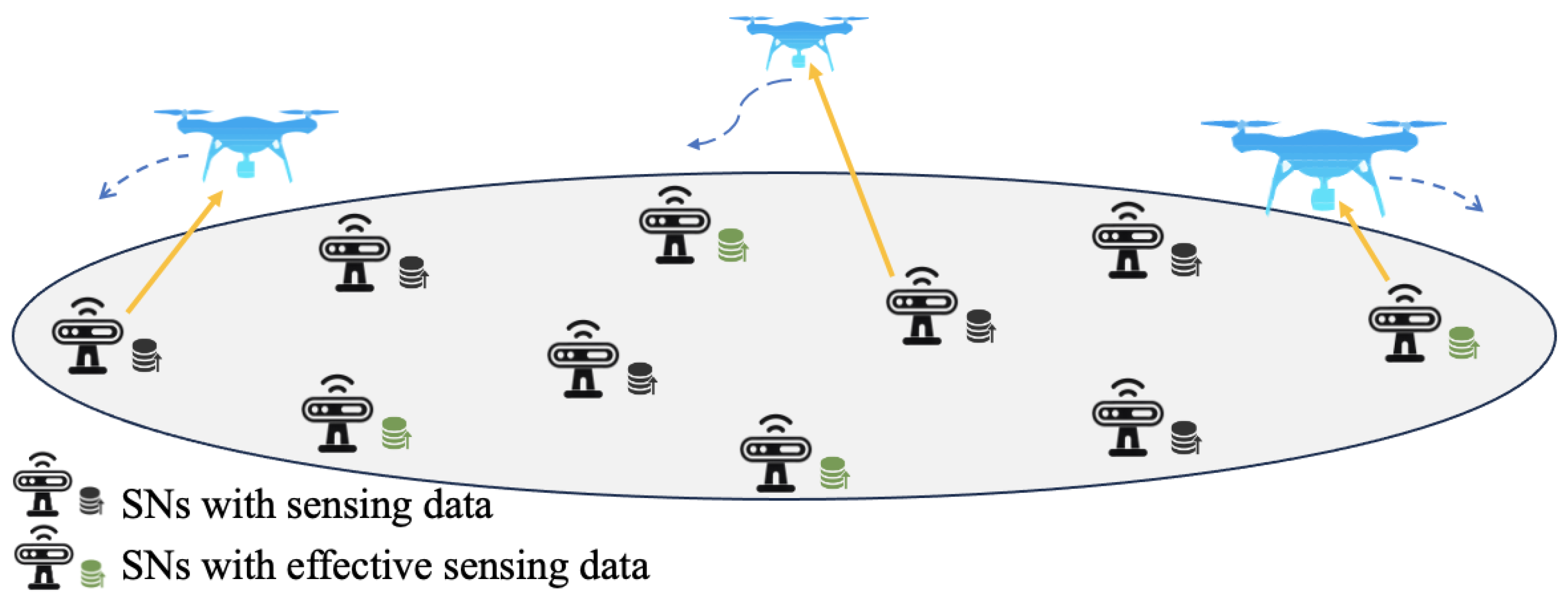


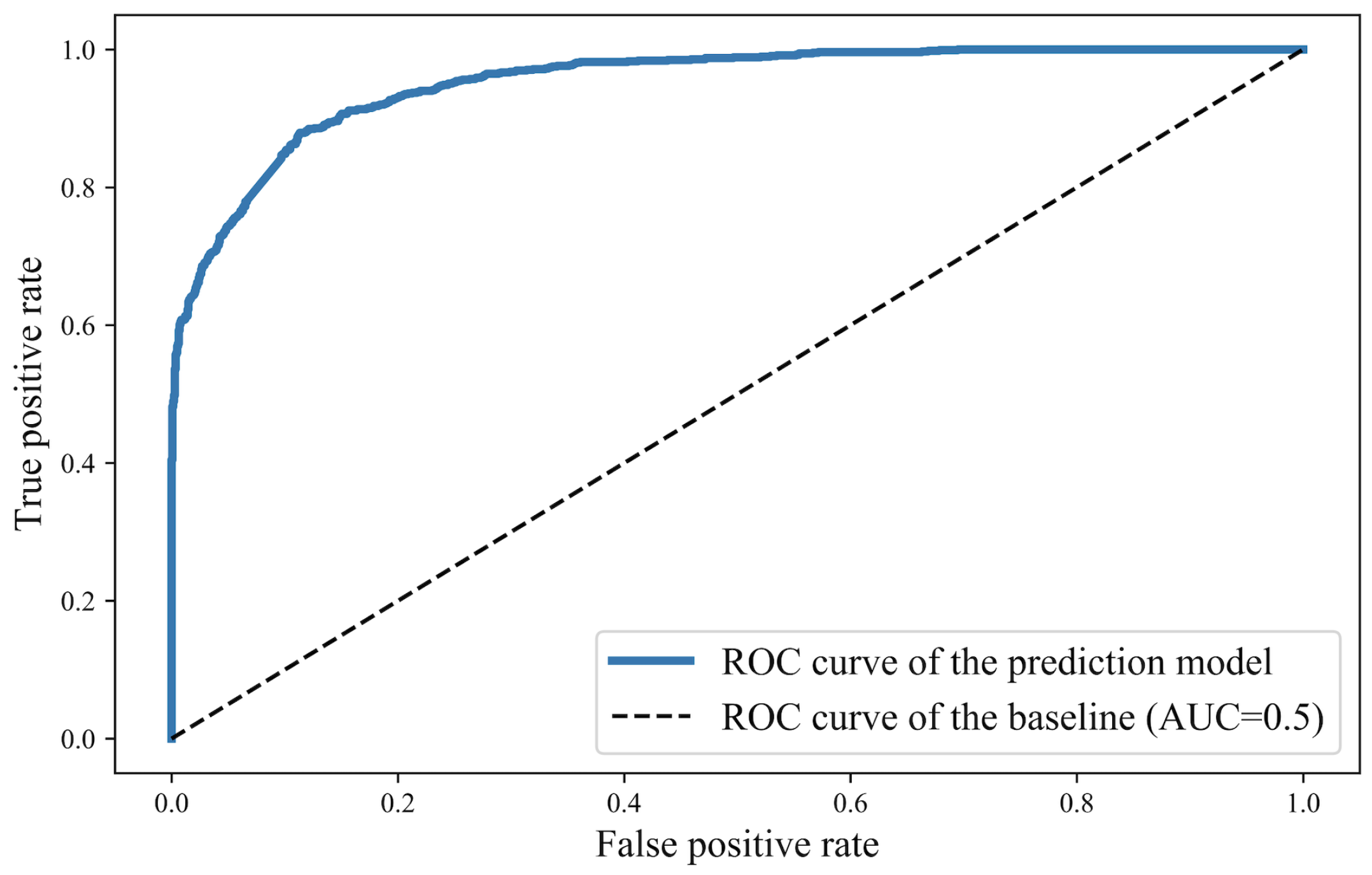
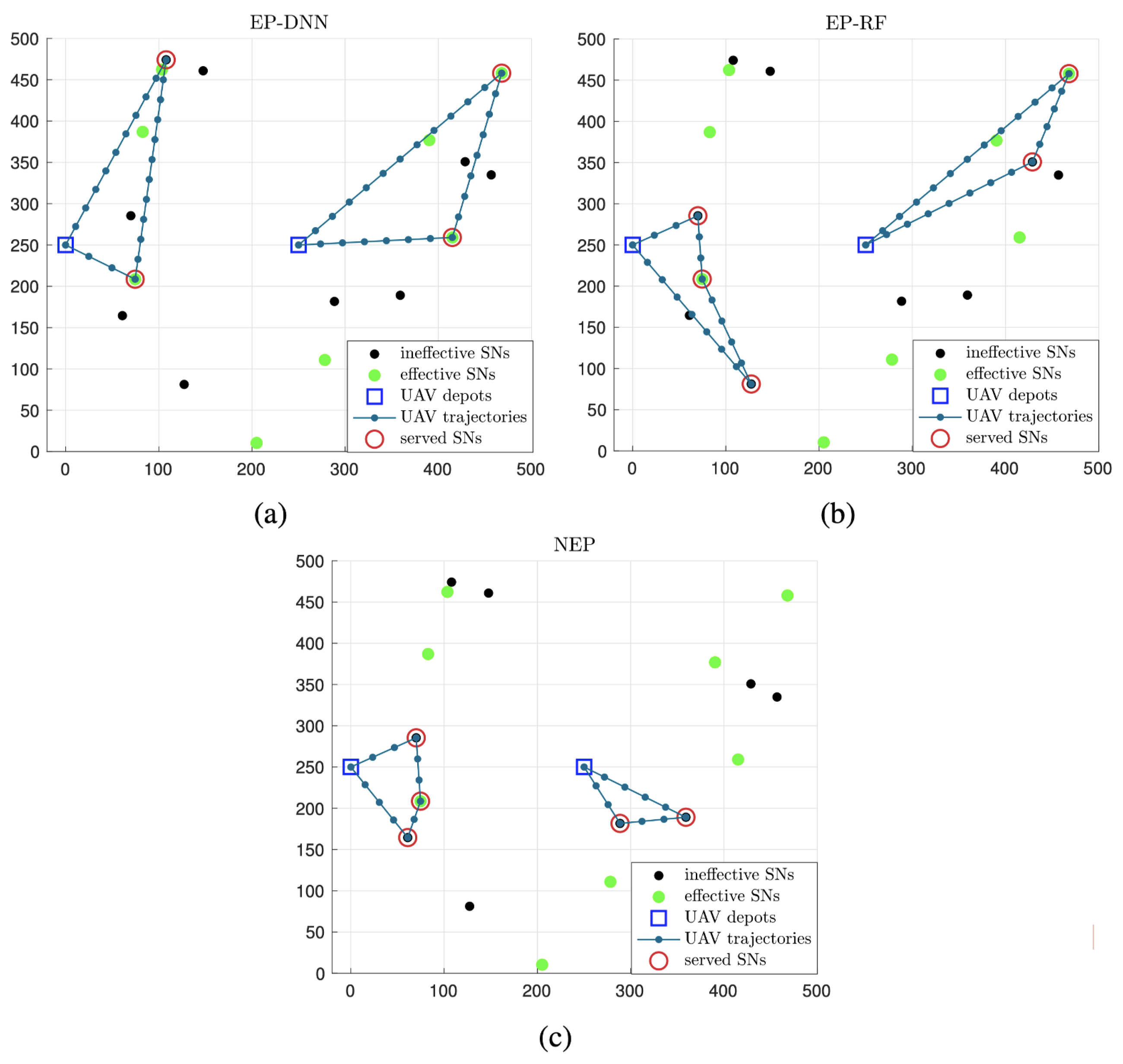
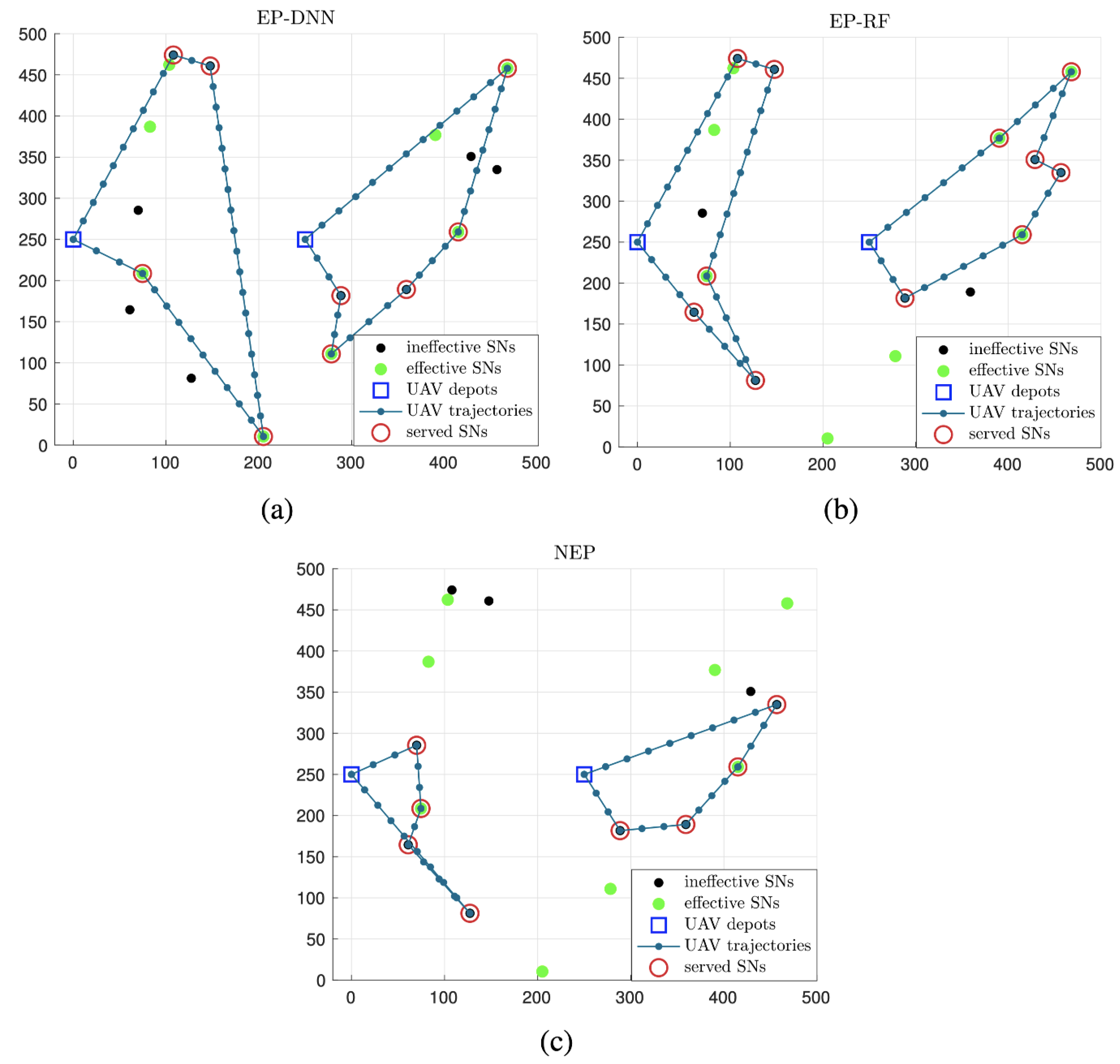
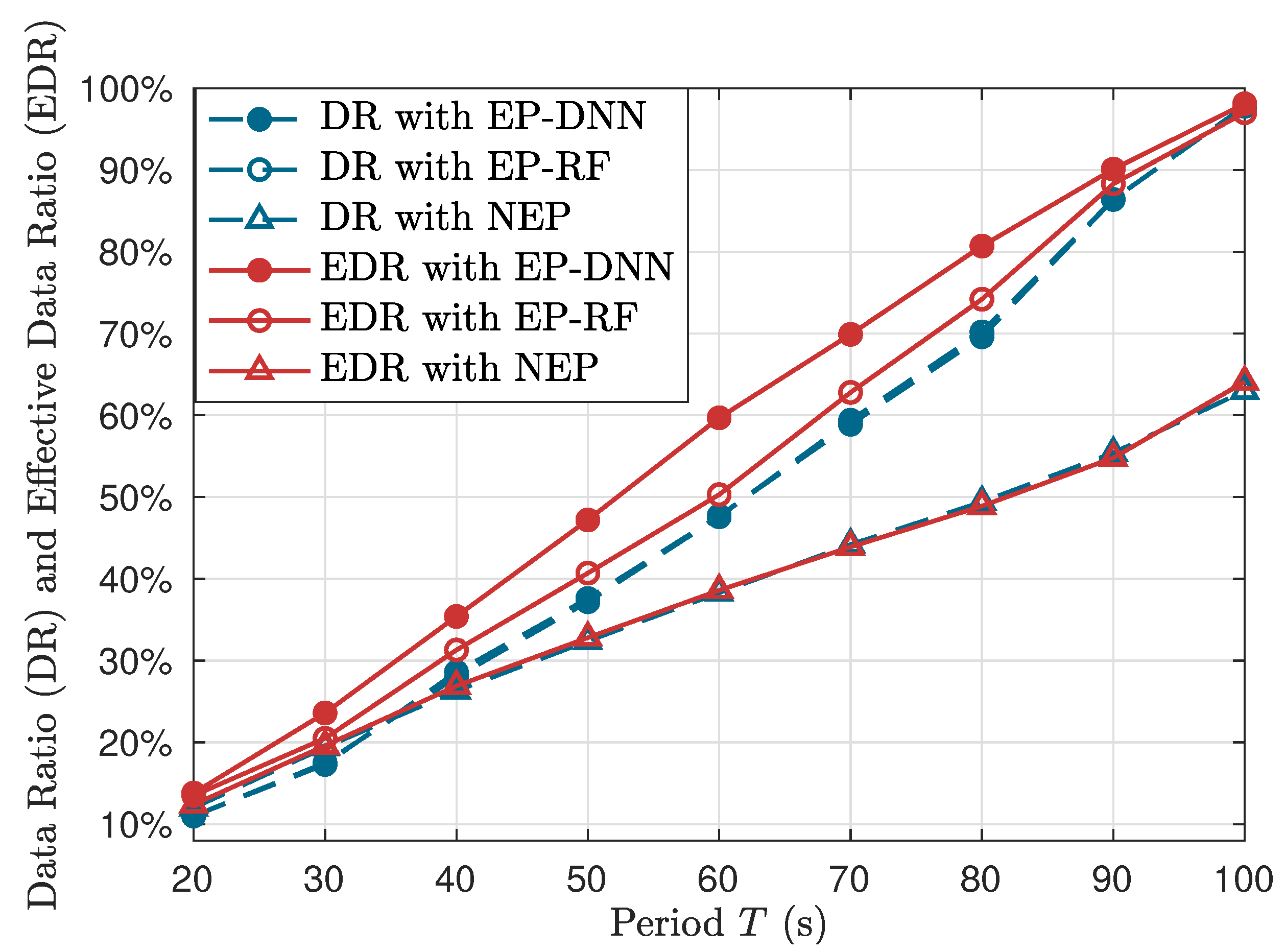
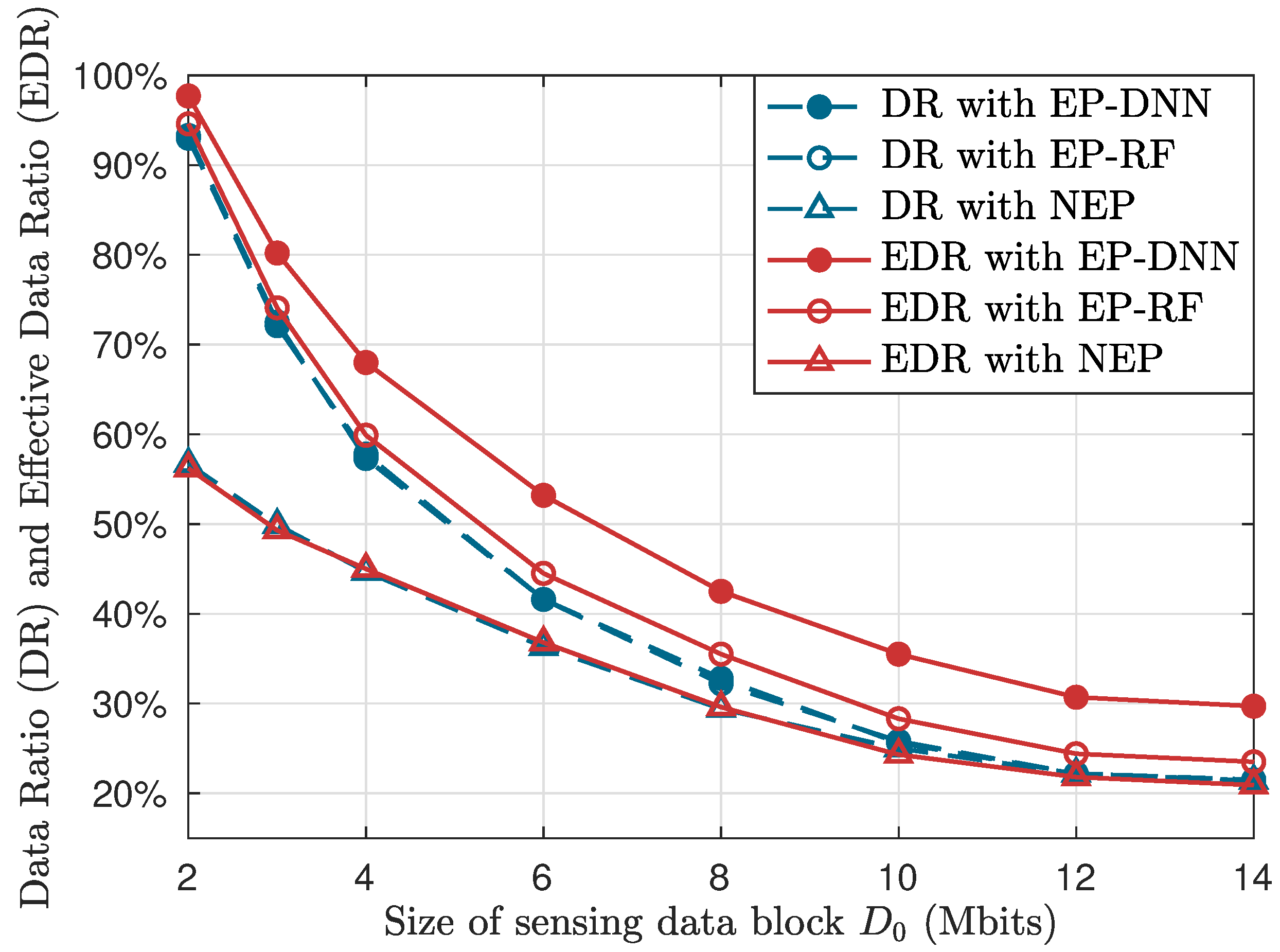
| Parameter | Description | Value |
|---|---|---|
| T | Flying period of UAV | 20–100 s |
| Sensing data block size | 2–14 Mbits | |
| Channel power gain at the reference distance 1 m | −30 dB | |
| Receiver noise power | −110 dBm | |
| Maximum discretization segment length | 5 m | |
| Maximum UAV speed | 20 m/s | |
| Minimum inter-UAV distance to ensure collision avoidance | 50 m | |
| Length of discretized time slot | 1 s | |
| Transmit power of SN | 5 mW | |
| H | Flying altitude of UAVs | 80 m |
Disclaimer/Publisher’s Note: The statements, opinions and data contained in all publications are solely those of the individual author(s) and contributor(s) and not of MDPI and/or the editor(s). MDPI and/or the editor(s) disclaim responsibility for any injury to people or property resulting from any ideas, methods, instructions or products referred to in the content. |
© 2024 by the authors. Licensee MDPI, Basel, Switzerland. This article is an open access article distributed under the terms and conditions of the Creative Commons Attribution (CC BY) license (https://creativecommons.org/licenses/by/4.0/).
Share and Cite
Du, Y.; Hao, J.; Chen, Z.; Guo, Y. Indeterministic Data Collection in UAV-Assisted Wide and Sparse Wireless Sensor Network. Sensors 2024, 24, 6496. https://doi.org/10.3390/s24196496
Du Y, Hao J, Chen Z, Guo Y. Indeterministic Data Collection in UAV-Assisted Wide and Sparse Wireless Sensor Network. Sensors. 2024; 24(19):6496. https://doi.org/10.3390/s24196496
Chicago/Turabian StyleDu, Yu, Jianjun Hao, Zijing Chen, and Yijun Guo. 2024. "Indeterministic Data Collection in UAV-Assisted Wide and Sparse Wireless Sensor Network" Sensors 24, no. 19: 6496. https://doi.org/10.3390/s24196496







